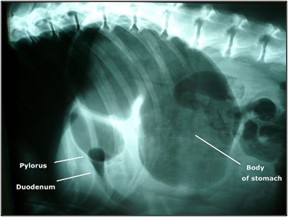PCPR Lesson 3- Bloat
Bloat (Gastric Dilatation Volvulus)
Bloat is an extremely serious condition that should be considered a life- threatening emergency. Dog owners must contact their veterinarians immediately if they suspect that their dog has bloat. Dogs can die of bloat within several hours. Even with treatment, as many as 25-33% of dogs with GDV die.
The gastric dilatation is one part of the condition and the volvulus or torsion is the second part. In bloat (dilatation), due to several different and sometimes unknown reasons, the stomach fills up with air and puts pressure on the other organs and diaphragm. The pressure on the diaphragm makes it difficult for the dog to breathe.
The air-filled stomach also compresses large veins in the abdomen, thus preventing blood from returning to the heart. Filled with air, the stomach can easily rotate on itself, thus pinching off its blood supply. Once this rotation (volvulus) occurs and the blood supply is cut off, the stomach begins to die, and the entire blood supply is disrupted and the animal’s condition begins to deteriorate very rapidly.
Dog with swollen stomach and hunched position with bloat
Not all dogs that have a gas buildup and resultant dilatation develop the more serious and life-threatening volvulus. However, almost all dogs that have a volvulus develop it because of a dilatation. There are several breeds that have a higher occurrence of bloat than others. Large breed dogs with deep, narrow chests are more likely to develop bloat.
Some of those breeds include:
- Great Dane
- Saint Bernard
- Weimaraner
- Irish Setter
- Gordon Setter
- Standard Poodle

Above image: An x-ray showing gastric dilatation and volvulus in a large mixed-breed dog. The large dark area is the gas trapped in the stomach. The pylorus and duodenum are in an abnormal position cranial to the stomach and are separated by a fold in the stomach, creating a “double bubble” appearance
The most obvious signs are abdominal distention (swollen belly) and vomiting where the animal does not throw anything up. Other signs include restlessness, abdominal pain, and rapid shallow breathing. Profuse salivation may indicate severe pain.
If the dog’s condition continues to deteriorate, especially if volvulus has occurred, the dog may go into shock and become pale, have a weak pulse, a rapid heart rate, and eventually collapse. A dog with gastric dilatation without volvulus can show all these signs, but the more severe signs are likely to occur in dogs with both dilatation and volvulus.
Veterinarians suspect that certain factors such as drinking too much water, gulping down food quickly, exercising too soon before or after eating can lead to bloat. If you suspect that your dog has bloat you need to get them to a veterinarian as quickly as possible. There is nothing you can do at home and getting them prompt emergency veterinary care will be the only way to hopefully save their life. Try to keep the animal as still as possible.
If you suspect that your dog may be at risk of bloat there may be some options to help prevent an episode. Below is a list of suggestions:
- Feeding several small meals each day
- Not feeding from an elevated food bowl
- Avoiding dry kibble
- Offering water at all times
- Trying to reduce stress, especially around feeding time
